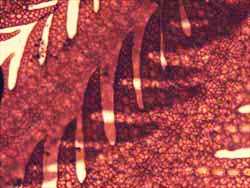Ptilota filicina, along with other algae, is a powerful concentrator of chemical elements in seawater. The alga probably uptakes these elements for important physiological processes such as oxidation and reduction processes. Red algae, specifically of the order Ceramiales, are especially potent at forming complex compounds that increase the uptake of chemical elements by several hundred fold. P. filicina specifically uptakes Cu, Zn, Ni, Fe, V, Ti, Mn, Mo. This process could be useful in harvesting micro elements from algae and in taxonomical distinction (Saenko 1976).
A study completed in Hokkaido, Japan documents the succession of algal communities on anthropogenic marine structures. It finds that the perennial P. filicina, along with several other small reds, dominates over the Laminaria angustata kelp. P. filicina occupies space and prevents the adhesion of Laminaria zoospores to surfaces and subsequent germination. Also, researchers reported a strong correlation with the biomass of these small red algae and the population density of amphipod communities (Sato 2004).
Saenko, G. N., M. D. Koryakova, V. F. Makienko, and I. G. Dobrosmyslova. 1976. Concentration of polyvalent metals by seaweeds in Vostok Bay, Sea of Japan. Marine Biology 34:169-176.
Sato, K., K. Adachi, Y. Ohsawa, and S. Okamoto. Succession of marine algae community around coastal structure. 2004. Oceans. 2: 713-718. |

